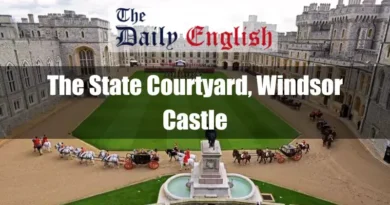I. Introduction
The Long Walk’s genesis dates back to the 1680s, during the reign of Charles II. Both a testament to his power and a serene escape for his court, Charles II, a monarch known for his love of grandeur, commissioned landscape architect Réginald Blom to design a grand avenue leading away from Windsor Castle. Thus, amidst the hustle and bustle of royal life, The Long Walk emerged, a haven of nature and contemplation within the castle’s embrace.
The Long Walk in Windsor stretches a majestic 4.2 kilometers, or 2.64 miles, from the castle gates to the iconic Copper Horse statue. At a leisurely pace, it takes about 45 minutes to complete the walk one way, offering ample time to soak in the scenery and royal history. The starting point is conveniently located at the southern end of George IV’s Gateway, just outside the castle gates, inviting you to embark on a journey through time and nature.
Initially conceived as a private retreat for the royals, The Long Walk soon blossomed into a multipurpose space. It served as a training ground for horses and a hunting route. Public access was eventually granted, transforming The Long Walk into a beloved destination for locals and visitors alike. Today, it stands as a vibrant artery of the Windsor community, a place for strolls, social gatherings, and quiet reflection under the watchful gaze of the castle walls.
II. The Long Walk Through the Ages

To truly understand The Long Walk’s magic, we must embark on a historical voyage, stepping through the eras that shaped its character:
A. 17th Century
- 1680s: Under Charles II, The Long Walk takes its first steps, initially a dirt track lined with saplings.
- 1685: The avenue’s construction nears completion, with gravel replacing dirt.
- Late 17th Century: The Long Walk served as a private retreat for the royals and was used for strolls and horse exercises. Limited public access on designated days allows residents to glimpse this regal haven.
- Restoration of Windsor Castle after Devastating Fire in 1992.
- State Apartments at Windsor Castle: An Ultimate Guide.
B. 18th Century
- 1714-1820: The Georgian era ushered in a period of refinement for The Long Walk. Queen Anne had previously added a central carriage road in 1710. During this period, the avenue was widened, gravelled, and flanked by rows of elm trees, creating a picture-perfect promenade.
- 1768: The iconic Copper Horse statue of King George III was unveiled, adding a monumental landmark and a symbol of royal power.
- 1782-1805: King George III became a regular walker on The Long Walk, interacting with the public and solidifying its role as a social space.
- Late 18th Century: Fashionable society embraced The Long Walk, making it a popular venue for strolls, picnics, and romantic encounters.
C. 19th Century
- 1805-1837: The Regency period saw further public access granted. Carriages became a common sight alongside pedestrians on the avenue. While the use of hot air balloons on The Long Walk remains unconfirmed, other leisure activities likely flourished.
- 1814: The Long Walk became part of the grand celebration route for Queen Charlotte’s Jubilee, showcasing its ability to accommodate large crowds.
- 1837-1901: The Victorian era expanded public access even further. Cricket matches, cycling races, and even roller skating became popular sights along the path.
- 1848: The Long Walk became the regular course for the prestigious Eton College Regatta, adding a touch of sporting spirit.
- Late 19th Century: The rise of cycling found The Long Walk perfectly suited for leisurely rides and competitive races, further solidifying its connection to the evolving world. However, the late 19th and early 20th centuries devastated the elm trees due to Dutch Elm disease. Replanting efforts were undertaken to preserve the avenue’s character.
- St. George’s Chapel at Windsor Castle in History & Today.
- Queen Mary’s Dollhouse at Windsor Castle.
- Windsor Great Park Stables: History and Today
D. 20th Century

- 1901-1952: The Edwardian and Interwar eras ushered in the adaptation period for The Long Walk. The automobile’s arrival necessitated wider paths and designated parking areas. The avenue continued to witness both the pomp of royal processions and the solemnity of war.
- 1910: World War I cast a shadow over The Long Walk. Public gatherings became less frequent, and the once-bustling avenue became a place of quiet contemplation for those affected by the conflict.
- 1920s-1930s: The rise of motoring led to the creation of dedicated lanes for cars and bicycles, ensuring the safety and comfort of all users. The Long Walk continued to evolve with the times.
- 1939-1945: World War II once again transformed the avenue. Access to Deer Park likely became restricted, and The Long Walk might have provided a place of solace for soldiers stationed at Windsor. Its proximity to the castle likely offered a sense of security and a reminder of the enduring spirit of the nation.
- 1952-2000: The post-war era brought a focus on conservation efforts. Damaged trees were replaced, and the avenue was meticulously restored. The Long Walk regained its vibrancy, becoming a popular spot for tourists and locals seeking a tranquil escape.
- Windsor Guildhall Near Windsor Castle: Past and Today
- Also, know about The Best Bits of Windsor Castle
E. 21st Century
- 2000-Present: The Long Walk embraces the modern age. Community events, marathons, and even open-air cinema screenings breathe new life into the avenue. It becomes a hub for fitness enthusiasts, dog walkers, and families enjoying a picnic under the watchful gaze of the castle.
- 2009: The avenue hosts the “Queen’s Diamond Jubilee Walk,” showcasing its ability to unite large crowds in celebration.
- 2011: The eyes of the world turn to The Long Walk as it features prominently in the Royal Wedding of Prince William and Kate Middleton, etching its image in the global consciousness.
- 2023 onwards: The Long Walk thrives, a testament to its enduring appeal. It remains a cherished landmark, a symbol of Windsor’s rich history, and a haven for those seeking a connection with nature, community, and the timeless elegance of a bygone era.
- Windsor Great Park: A Legacy of History, Nature, and Royal Heritage.
- Eton College Windsor: A Legacy of Excellence
- Frogmore House Windsor: A Royal Retreat Through Centuries
III. The Long Walk: Beyond the Trees
The Long Walk’s magic extends far beyond its rows of trees. It’s an ecosystem teeming with life and steeped in symbolism:
A. Flora and Fauna
The avenue boasts an array of flora, from ancient oaks and elms to vibrant wildflowers and carpets of moss. It shelters diverse fauna, from playful squirrels and majestic deer to flitting butterflies and chirping birds, creating a harmonious tapestry of nature.
B. The Deer Park
The Long Walk leads directly to the vast expanse of Windsor Great Park, home to the historic Deer Park. This ancient hunting ground, established by William the Conqueror, adds a touch of wildness and connects The Long Walk to centuries of royal history.
- Windsor Castle Opening Times: Everything You Need to Know.
- Windsor Castle Tickets: A Proven Comprehensive Guide.
- The Windsor Castle Dogs
C. The Copper Horse
Standing proud at the avenue’s head, the Copper Horse statue of George III reigns supreme. More than just a sculpture, it’s a symbol of royal power, a testament to the enduring legacy of the monarchy, and a popular landmark for visitors and photographers alike.
D. The Long Walk in Popular Culture
This iconic avenue has transcended its physical boundaries, weaving into the fabric of literature, film, and art. From Jane Austen’s novels capturing its romantic charm to contemporary paintings depicting its serene beauty, The Long Walk has captivated the imagination of artists across generations.
E. Conservation Efforts and Future Sustainability
Several initiatives recognizing the Long Walk’s historical and cultural significance ensure its continued existence. Regular maintenance, tree replanting programs, and responsible tourism practices safeguard this national treasure for future generations.
IV. Conclusion
The Long Walk is a testament to the enduring spirit of Windsor and Britain. Its story is a tapestry woven from royal processions and public revelry, quiet contemplation, and the ever-changing tides of history. It’s a place where nature and humanity converge, monarchs and commoners have shared the same path, and where the echoes of the past resonate with the joy of the present.
- Windsor Castle Changing of the Guard: Where History Coming Alive.
- Windsor Castle Tour: A Comprehensive and Best Guide.
- A Symbol of Windsor’s Enduring Spirit: The Long Walk embodies the essence of Windsor – a blend of regal grandeur and community spirit. It reflects the town’s evolution through the centuries, adapting to changing times while retaining its timeless elegance.
- A Place for Reflection, Recreation, and Connection: It offers something for everyone. It’s a haven for solo reflection under the ancient trees, a stage for vibrant community events, and a playground for children chasing squirrels and families enjoying picnics. It’s a place to connect with nature, history, and the essence of being human.
- The Long Walk’s Future: As we look ahead, we are responsible for ensuring The Walk’s legacy endures. Continued conservation efforts, responsible usage, and appreciation for its unique character will guarantee that this majestic avenue continues to grace the grounds of Windsor Castle for generations to come.
V. FAQs about The Long Walk at Windsor Castle
1. What inspired Charles II to create The Long Walk?
Charles II’s inspiration for The Long Walk likely stemmed from a combination of factors:
- Aesthetics: French formal gardens, particularly Versailles’ Grand Walk, were in vogue. The Long Walk echoed this grandeur, showcasing Charles’ desire for a modern, impressive English landscape.
- Recreation: Charles loved physical activity like walking and racing horses. The Long Walk provided a dedicated space for these pursuits, away from prying eyes.
- Power and control: The Long Walk’s straight, imposing line extended the monarch’s visual dominion over the landscape, symbolizing his authority and control.
- Nature and privacy: Despite the formality, The Long Walk offered a peaceful escape from courtly life, allowing Charles to commune with nature and find solitude.
Likely, Charles wasn’t driven by a single inspiration but rather a confluence of these elements that resonated with his interests and the political climate of the time.
- Windsor Castle Tickets Advantage Card: Know Everything.
2. What is the significance of the Copper Horse statue of George III?
The Copper Horse statue of King George III holds significance on multiple levels. Erected by his son, it’s a respectful tribute to a complex monarch. Artistically, it’s a pivotal piece, credited to sculptor Sir Richard Westmacott, reviving British equestrian sculpture in bronze. Historically, it marks the end of The Long Walk, a grand avenue symbolizing royal power and a king’s connection to nature. Locally, it’s a beloved landmark, nicknamed affectionately, quietly standing guard over Windsor’s history.
3. What role did The Long Walk play during historical events like Queen Charlotte’s Jubilee and World War II?
a) Queen Charlotte’s Jubilee:
- The stage for grandeur: The Walk’s impressive length and formal design provided a magnificent setting for the celebratory procession, showcasing the Queen’s power and the nation’s prosperity.
- Public engagement: Crowds lined the avenue, cheering as the royal party passed, creating a direct connection between the monarchy and the people.
- Symbolic extension: The Walk’s reach beyond the castle walls subtly extended the Jubilee’s festivities to the surrounding landscape, amplifying its impact.
b) World War II:
- Training ground: The Walk’s secluded nature and ample space made it ideal for training soldiers, away from prying eyes and potential dangers.
- Physical fitness: Recruits honed their marching and endurance on the long, straight path, preparing for the physical demands of war.
- Mental resilience: The Walk’s tranquillity offered a brief escape from wartime stress, allowing soldiers moments of peace and reflection.
The Long Walk transcended its intended purpose in both events, becoming crucial in shaping historical narratives.
4. What makes The Long Walk more than just a pathway?
The Long Walk transcends mere pavement. It’s a living tapestry woven with threads of history, a canvas where grandeur unfolds and quiet contemplation finds refuge. It whispers of bygone eras, its path echoing with the tread of royal processions and soldiers’ boots. The ancient trees sigh secrets in the breeze, each rustle a testament to the passage of time.
A symbol of power reaching into nature’s embrace, The Long Walk is both a stage for public spectacle and a hidden sanctuary for weary souls. It’s more than a path – it’s a timeline etched in Earth, a performance space where history comes alive, and a portal leading to inner peace. In its elegant simplicity, The Long Walk weaves together the past, present, and the reflective, transforming from a pathway into a living narrative, forever unfolding.
- How Far is Windsor Castle from Buckingham Palace? Royal Mile?
- The Windsor Castle Fire 1992: A Historical Catastrophe.
5. How has The Long Walk influenced popular culture?
The Long Walk’s influence on popular culture is subtle yet enduring. Its grandeur has inspired painters, poets, and photographers, capturing its serene beauty and regal presence. Literature reflects its symbolic weight – Dickens’ characters stroll it, reflecting on power and class. Its use in film and TV, like “The King’s Speech,” cements its visual association with monarchy and history. Even music feels its pull, with bands like The Long Ryders echoing its name and melancholy spirit. While not a direct source of pop culture tropes, The Walk’s quiet influence permeates a timeless backdrop for stories of power, reflection, and the enduring allure of nature.
6. What initiatives ensure the conservation of The Long Walk?
Ensuring The Long Walk’s grandeur for future generations requires a multifaceted approach:
a) Historic Landscape Restoration:
Recognizing its cultural significance, The Crown Estate initiated a comprehensive restoration project in partnership with Historic England. This meticulous work involves archival research, specialist tree surgeons, and traditional craftsmanship to conserve the avenue’s historic character, from the iconic horse-chestnut trees to the hand-dug drainage ditches.
b) Biodiversity and Ecology:
The Long Walk isn’t just about aesthetics; it’s a vital habitat. The Windsor Estate actively manages the grassland and woodland edges, creating havens for birds, bats, and invertebrates. Invasive species are controlled, and native plants are reintroduced, fostering a biodiverse corridor.
c) Community Engagement:
The Long Walk isn’t just for the royals; it’s for the public. Regular guided walks, volunteer opportunities, and educational programs cultivate a sense of ownership and appreciation amongst locals and visitors alike. This fosters a community dedicated to its preservation.
These initiatives, ongoing maintenance, and research ensure that The Walk’s legacy endures. It’s not just a path; it’s a living testament to history, nature, and community, forever evolving while carefully preserving its timeless allure.
7. In what ways does The Long Walk embody the essence of Windsor?
The Long Walk isn’t merely a path; it’s the lifeblood of Windsor, pulsating with the town’s very essence. Its grand avenue whispers tales of royal grandeur, lined by ancient trees that stand as silent sentinels for centuries. They’ve witnessed the pomp of monarchs’ processions and the quiet contemplations of courtiers, embodying the weight of history.
This avenue transforms into a stage for spectacle. Here, the grandeur of Queen Charlotte’s Jubilee unfolded, and soldiers trained for war, their unwavering steps echoing along the path – a testament to Windsor’s resilience.










Comments are closed.